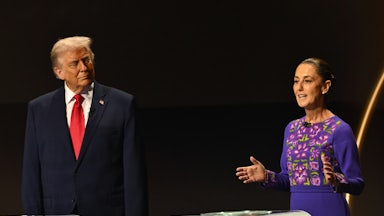In June, Meet the Press host Chuck Todd pressed House January 6 select committee member Representative Jamie Raskin on his “barometer of success” for the summer hearings. “Is just getting an historical record enough?” Todd asked. “Or does there need to be some justice somewhere?” “Yes, there needs to be accountability,” Raskin responded, including “criminal accountability.” Though the committee’s ultimate project, he went on to say, was “telling the truth to the people so we can … fortify democratic institutions going forward.”
The committee will close its doors in the new year, and so far, not a single senior official has been indicted for attempting to overturn the 2020 presidential election. Nor, as some polls suggest, has truth-telling seemed to have moved many minds. On fortifying institutions: The committee will make its recommendations in a final report, though it is hard to imagine many coming to fruition, at least any time soon. So, then, was the exercise worthwhile? And are those the right metrics to say so?
The committee has functioned like a traditional commission of inquiry—a temporary public body tasked with investigating abuses of power. National commissions are now commonplace, offering plenty of examples to fashion reasonable expectations. Depending upon how one defines them, at least three dozen countries have stood up a commission in the past four decades (including the U.S., as with the Commission on Wartime Relocation and Internment of Civilians). Some seem to have excelled in lessening the likelihood of recurrence; others may have done more harm than good.
“Nunca Mas,” the final report of Argentina’s commission to investigate the abuses of the 1976–1983 military governments, documented in grim detail a campaign of terror that left tens of thousands of Argentines tortured and dead. It became an instant bestseller—and also formed the evidentiary backbone of the trials that came next. The body—modeled, as one of the commissioners explained, on “commissions set up by the United States Congress”—would collect over 50,000 documents and thousands of testimonies. It worked not only to reconstruct a collective memory but to lay real groundwork for subsequent accountability efforts.
In Thailand, by contrast, tepidness by a national commission to criticize the military for its obvious role in election-related violence led to a widely criticized report in 2012, which some scholars argue helped to pave the way for further abuses, including the 2014 military coup. In Peru, a national commission exercise generated a host of heated controversies—including accusations that it was unfairly critical of the military and downplayed the abuses of other armed actors—but nonetheless instigated institutional reforms, reparations, and high-level prosecutions, including of the former president.
Differing compositions, mandates, authorities, and contexts make an apples-to-apples analysis of these bodies difficult. But there are common through lines. At their best, research suggests they can succeed in at least three interrelated ways that help to fortify against future abuses.
First, national commissions can keep abuses politically salient, focusing public attention and refusing the temptation to hurriedly turn the page. This is perhaps the January 6 committee’s most incontrovertible success. Over two years after it began, the conspiracy to overturn the election has remained headline news. Despite attempts by Republican leaders to poison the proceedings—stripping the select committee vice chair of her party’s leadership position; propagating conspiracy theories about the House speaker’s role in the attack; character-assassinating various female witnesses—the committee has regularly plastered headlines across the country with its findings.
By this author’s count, the select committee landed on the front page of USAToday—the country’s largest paper by circulation—nearly 40 percent of the time during the summer hearings, and nearly each time featuring a story focused on the findings themselves (“Trump knew he lost but lied, witnesses say”; “Here’s what the first six revealed”). The scope and substance of coverage were not a given. As The Washington Post’s media critic Margaret Sullivan argued, success here might be in part because the facts presented at hearings were fodder for “actual news.”
In terms of viewership, not a single Trump-era congressional hearing topped the first select committee hearing this summer; and the hearings on average drew roughly twice as many viewers as the January 6 impeachment proceedings. Bucking forecasts that viewership would decline as the hearings went on, cable ratings steadily climbed. CNN’s average viewership increased from 1.5 million viewers during the first hearing to 2.9 million during the eighth; MSNBC’s jumped from 4.3 to 4.7 million. The counterfactual here is not hard to imagine: Absent the committee’s work, January 6 and the iceberg of illegality beneath may have faded from public view.
In June, Representative Mike Johnson, speaking at a House GOP press conference, characterized the committee’s work as “reliving and rehashing” January 6 while the American public had “moved on.” In February, however, a national poll found that only 35 percent of Americans thought “too much attention has been paid to the riot,” and in April, that 39 percent thought the committee was “too focused on the past.” In September, after eight hearings, 38 percent wanted them to end; 58 percent wanted more. Some are clearly eager to stop hearing about January 6; most are not.
Priscilla Hayner, a scholar of commissions, takes issue with the dichotomous presentation of focusing on the past versus moving on. Certainly, one way of moving on is to “bury the past”—an approach, though, that probably bodes poorly for “build[ing] a democratic future.” Instead, moving forward in a way that prevents “the repetition of abuses” usually requires a reckoning. In some respects, then, these investigations do function as a way of moving on—but through interrogation instead of forgetting, forcing a public to confront an uncomfortable reality in order to fix what broke. “Tough knowledge,” as Raskin has called it.
Where individual victims are concerned, commissions provide a means of sharing their stories and securing answers, apologies, and reparations: arguably all components to in fact moving forward. The U.S. Commission on Wartime Relocation and Internment of Citizens, for instance, provided a platform for public testimonies across the country, which led to a formal apology by the U.S. government and over $1 billion in reparations to Japanese American survivors.
During the January 6 hearings, law enforcement officers injured in the attack, along with the family members of those who perished, were regularly in attendance. Caroline Edwards, a member of the Capitol Police who suffered a traumatic brain injury, described in public testimony scenes of blood and vomit. Two defamed and harassed Fulton County election workers (whom my organization, Protect Democracy, represents) testified about the threats to their lives and devastation to their livelihoods that resulted from conspiracies propagated by the former president and his allies—a story shared by hundreds of election workers subjected to a still ongoing “campaign of intimidation,” including “threats of hanging, firing squads, torture and bomb blasts.”
Where the victims are democratic institutions, commissions can compel us to reconsider their resiliency and recommit to protecting them. “Preventing future abuses,” Hayner argues, is “perhaps the[ir] most important aim,” such as through issuing recommendations for institutional reforms and mobilizing public pressure behind them—something difficult to do without an honest assessment of what went wrong. While the near-term implementation of recommendations generated from these exercises is generally a mixed bag, commissions can set a policy agenda structured by their findings that focuses attention for years to come.
In November 2020, then–President-elect Biden shared with advisers that investigations into the prior administration risked consuming his presidency, and so preferred that the country “just move on.” Perhaps the events of January 6 changed that posture. Regardless, the select committee has, in effect, taken the choice away from him, all but ensuring that simply moving on without confronting what happened is no longer a reasonable expectation.
The committee’s expectation-setting is a consequence of its storytelling. Congressional investigations are unique in that they may communicate freely with the public. The committee—as with most other commissions of inquiry—also enjoys an exclusive platform. The panoply of investigations in-progress by other House committees in 2021 were subsumed by the select committee, and no other entity with a comparable public perch exists. Law enforcement may work in parallel, as it is doing here, but very much unlike law enforcement, the committee can make use of a national megaphone—and with it work to construct a more shared public understanding of what happened, and why: a second dimension of success.
It is an opportunity the committee has clearly seized. As law professor Josh Chafetz argues, the purpose of congressional investigations is not only to inform Congress itself, but also to shape public views—and shaping public views requires an adept performance. Indeed, the committee’s theatrical decisions appear carefully orchestrated: a clear and consistent narrator (Representative Liz Cheney); well-cast and surprising witnesses (predominantly Republicans and former Trump officials); and a coherent, compelling narrative (a seven-part conspiracy to subvert an election), complete with plot twists and cliff-hangers. (In fact, the committee relied on production support from a former ABC News president and documentarian.)
Working toward a more shared reality, this thinking goes, might help to engender a greater commitment to preventing a recurrence of abuses. Historian Anne Applebaum observed in June that, “These hearings are being run much like a Netflix series.” A compliment, to be sure—if the point is not only to fact-find, but to persuade the public of the credibility and gravity of those facts. “The designers of the January 6 committee’s hearings … have created a giant fact-checking project designed not only to write an accurate account of what happened in the run-up to the Capitol attack, but to convince people to believe it.” Equipped with a more shared understanding, the American public may be more watchful, and less tolerable, of future attempts to subvert democracy.
These commissions “can and do change the frame of public discourse and public memory,” argues historian Michael Ignatiff. “In Argentina, its work has made it impossible to claim, for example, that the military did not throw half-dead victims into the sea from helicopters.” In this sense, success is not the production of a clean and undisputed historical account, but instead a reduction in the “number of lies that can be circulated and unchallenged in public discourse.” The Rettig Report—from Chile’s commission to investigate abuses under the 1973–1990 military dictatorship—forced the military to suddenly and publicly defend a period it had previously celebrated, stripping the institution of its monopoly on history writing.
Various polls on attitudes toward January 6 and the former president’s role, though, are not particularly promising. Across a host of questions, answers pre and posthearings haven’t changed much: whether what happened on January 6 constitutes a threat to democracy; or whether the former president bears responsibility. Indeed, his support by and large “remains unmoved.” Writing the history and shaping the public memory of January 6 is still a young exercise, but it seems easy enough to claim that the project is not off to an encouraging start.
Still, upon closer inspection, the committee may in fact be “narrow[ing] the range of permissible lies,” to borrow Ignatiff’s frame. In recent polling by Protect Democracy and Citizen Data, for instance, we observed that even those who remain skeptical of the legitimacy of the 2020 election have increasingly come to believe that January 6 was characterized by violence. Between April and July, the number of election deniers who viewed January 6 as a violent attempt to overthrow the government nearly doubled, from 6.5 to 11 percent. Most of that increase came from those who were “uncertain” about January 6 prior to the hearings. While these margins are narrow, making progress on a more shared reality is a project better measured in inches, not miles.
Criticism of the committee on this dimension—that it has failed to meaningfully shift public attitudes—typically zeros in on the failure to change beliefs among Trump supporters. This may be true, and perhaps also the wrong metric. The near-total absence of accountability for the Bush administration’s unlawful torture program was probably not a function of failing to convince the program’s supporters of the wrongness of their ways. Instead, those already more inclined to pursue accountability chose not to. The New York Times editorial board called for prosecutions; then-Senator Patrick Leahy advocated for a truth commission. But assessing little public appetite for either, the Obama administration—with a president who had campaigned on the matter—brushed calls for accountability aside.
The committee’s storytelling function may be less about changing Trump supporters’ minds and more about fortifying the wherewithal of those already inclined to support accountability. The hearings have contributed to progress on this front. Over the course of the summer, according to our polling, those who believed in the legitimacy of the 2020 election became more likely to rank “preventing a repeat of January 6” as a personally important issue, suggesting a deepening intensity of preferences among those already predisposed to want the perpetrators of January 6 held to account. There is also, of course, now a chorus imploring us not to look away—from Republican former Justice Department officials and retired four-star admirals and generals, to business leaders and legal scholars—including not a few who, over the course of the hearings, changed their minds. The question is no longer whether accountability is appropriate—but how, and for whom.
So is accountability coming? Even if not their ostensible purpose, these bodies can buttress other accountability mechanisms that outlast them, such as criminal investigations and prosecutions: a third useful metric of success. Commissions of inquiry elsewhere have frequently coupled their work with referrals to law enforcement or are nonetheless followed by prosecutions given the criminality they surface. (In Latin America, every national commission exercise has been followed by trials.) “These bodies can have significant long-term consequences that may be entirely unexpected at the start,” Hayner observes. “This seems to be particularly true in the realm of criminal justice.”
Because criminal investigations tend to take much longer, and sometimes start much later, commissions can play early and determinative roles. The counterfactual here is perhaps less certain: Maybe the Justice Department’s current investigations would be just as aggressive absent the committee’s work. But this seems unlikely. Federal prosecutors were apparently “astonished” by certain evidence made public by the committee. As The New York Times reported this June, White House aide Cassidy Hutchison’s “explosive testimony … may have increased the likelihood of new prosecutions,” or at the very least, created “an investigative roadmap” for prosecutors. The evidence of potential criminality is considerable, and the committee has established processes for sharing it with both state and federal prosecutors. If senior officials are indicted for their roles in attempting to subvert the 2020 presidential election, it will be difficult to argue the committee played no part.
As with the select committee, the Argentine commission’s mandate was not to try criminal behavior. But it nonetheless shaped the subsequent criminal trials. Nunca Mas explicitly recommended prosecutions and continued investigations; the new democratic government used the report when communicating about the trials with the public; and the extraordinary volume and quality of underlying evidence served as the prosecution’s key resource.
Just as Argentina’s commission was a novel innovation—arguably the world’s first—so too was what came next. Never before had a Latin American country prosecuted its leaders for criminal behavior. At the time, critics warned that the commission’s work would be fruitless, and that prosecutions would undermine Argentina’s fragile democracy. The opposite seems to have come true: As political scientists Kathryn Sikkink and Carrie Booth Walling observe, Argentina has conducted more trials of former leaders “than any other country in the world and has enjoyed the longest uninterrupted period of democratic rule in its history.” Just this July, an Argentine court sentenced another 19 former military officials to jail.
Representative Liz Cheney, the select committee’s vice chair, warned during the final public hearing in October that “[w]ithout accountability, it all becomes normal, and it will recur.” Whatever the committee’s impact, it will almost certainly be understood by what happens after it’s gone.










